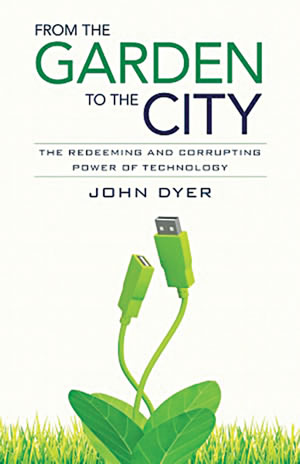
From the Garden to the City
Description : John Dyer’s vocation, Director of Web Development for Dallas Theological Seminary, combines his dual passions of “teaching the Bible” and “computer programming” (14); it also renders him capable of writing on the philosophy of technology. Dyer challenges outright the neutrality of technology, and ultimately desires his readers to affirm that “technology changes everything” (175). By affirming such, the reader must then scrutinize their position in a technological age in which they may neither “be content merely to criticize technology” nor may they dismiss its shortcomings “and use technology as much and as often as we can . . . because at Christ’s return he will remake all things, including our problematic technology” (176). Such scrutiny leads to a course of action prescribed by Dyer which “will help us become better stewards of the technological tools God has entrusted to us” as we seek to live lives pleasing to Him (179).
Dyer reaches these goals by quickly presenting the issues generally associated with technology and then traveling back to the Garden of Eden to provide a common genesis of thought. After describing the mutual transforming power of humanity’s tools, like a simple shovel, he defines technology as “the human activity of using tools to transform God’s creation for practical purposes” (65). A major point of this early section is that the creativity evident in man’s design of these tools reflects the image of God and His creativity in man. He then notes the fallen nature of mankind, and necessarily, technology, but continues on to argue that God’s redemptive acts, as portrayed in the Ark and the cross, show God’s pleasure and interest in mankind’s creativity as well as its redemption. Next Dyer deals with the restoration of mankind by God to a perfect state. This state will be the new Jerusalem, which represents the restoration of a city, one of man’s earliest and greatest technological achievements, a reoccurring theme throughout the Bible and Dyer’s book. In conclusion Dyer presents how this information should transform the way Christians think about technology.
Dyer’s use of language appeals to a wide audience, not only by his sparse use of philosophical and theological jargon, but also by his continual reference to both those younger readers who, in general, are comfortable with the latest technology as well as their older counterparts who are wary of newer technology. To disarm either side, Dyer returns to Socrates’ distrust of what was the novel technology of writing and explains that each age brings about a generational trust and distrust of new technology.
Many readers, of either age, would expect this book to showcase a definite answer to the dark side of the internet, the proper use of projectors in church, and whether or not smart phone Bibles should be used by the congregants. Dyer, though mentioning several of these issues, focuses on how the Christian should live his life in awareness and repulsion of technology’s fallen nature. Evaluating a technology’s worth, experimenting with its intricacies, limiting its role in your life, making sure to communicate with Christian friends during the previous steps, and supporting those who actively invent technology to promote redemptive projects complete the method by which Dyer would suggest a Christian keep abreast of and involved in technology in their own time, which is to say, between the garden and the city.
For Christians familiar with common instructions concerning the handling of objectionable elements, Dyer’s book presents precious few new strategies for the confronting thereof; however, the strength of this book, and the reason I would recommend it, lies in Dyer’s ability to demonstrate technology as a fundamentally flawed, not neutral, creation of mankind and the corresponding new mindset the reader must develop based on such an assertion. Fundamentalists may find issues with Dyer’s reported freelance work with Anheuser-Busch and his non-confrontational approach to gray areas (14, 83).


